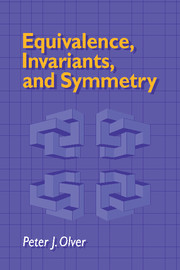Book contents
- Frontmatter
- Contents
- Preface
- Acknowledgments
- Introduction
- 1 Geometric Foundations
- 2 Lie Groups
- 3 Representation Theory
- 4 Jets and Contact Transformations
- 5 Differential Invariants
- 6 Symmetries of Differential Equations
- 7 Symmetries of Variational Problems
- 8 Equivalence of Coframes
- 9 Formulation of Equivalence Problems
- 10 Cartan's Equivalence Method
- 11 Involution
- 12 Prolongation of Equivalence Problems
- 13 Differential Systems
- 14 Frobenius' Theorem
- 15 The Cartan–Kähler Existence Theorem
- Tables
- References
- Symbol Index
- Author Index
- Subject Index
7 - Symmetries of Variational Problems
Published online by Cambridge University Press: 05 August 2012
- Frontmatter
- Contents
- Preface
- Acknowledgments
- Introduction
- 1 Geometric Foundations
- 2 Lie Groups
- 3 Representation Theory
- 4 Jets and Contact Transformations
- 5 Differential Invariants
- 6 Symmetries of Differential Equations
- 7 Symmetries of Variational Problems
- 8 Equivalence of Coframes
- 9 Formulation of Equivalence Problems
- 10 Cartan's Equivalence Method
- 11 Involution
- 12 Prolongation of Equivalence Problems
- 13 Differential Systems
- 14 Frobenius' Theorem
- 15 The Cartan–Kähler Existence Theorem
- Tables
- References
- Symbol Index
- Author Index
- Subject Index
Summary
The applications of symmetry groups to problems arising in the calculus of variations have their origins in the late papers of Lie, e.g., [154], which introduced the subject of “integral invariants”. Lie showed how the symmetry group of a variational problem can be readily computed based on an adaptation of the infinitesimal method used to compute symmetry groups of differential equations. Moreover, for a given symmetry group, the associated invariant variational problems are completely characterized using the fundamental differential invariants and contact-invariant coframe, as presented in Chapter 5. This result lies at the foundation of modern physical theories, such as string theory and conformal field theory, which are constructed using a variational approach and postulating the existence of certain physical symmetries. The applications of Lie groups to the calculus of variations gained added importance with the discovery of Noether's fundamental theorem, [178], relating symmetry groups of variational problems to conservation laws of the associated Euler–Lagrange equations. We should also mention the applications of integral invariants to Hamiltonian mechanics, developed by Cartan, [33], which led to the modern symplectic approach to Hamiltonian systems, cf. [165]; unfortunately, space precludes us from pursuing this important theory here. More details on the applications of symmetry groups to variational problems and to Hamiltonian systems, along with many additional physical and mathematical examples, can be found in my earlier text [186]. Included in our presentation is a discussion of the Cartan form for scalar variational problems, and some new applications to the classification of invariant evolution equations, which have recently arisen in applications to computer vision.
- Type
- Chapter
- Information
- Equivalence, Invariants and Symmetry , pp. 221 - 251Publisher: Cambridge University PressPrint publication year: 1995



